TBK1
-
Official Full Name
TANK-binding kinase 1 -
Overview
TBK, also known as IkappaB kinase (IKK)-related kinase NAK, belong to the serine/threonine IKK kinase family and is thought to play a role in NF-kappa-B (NF-kappaB) activation. The NF-kappaB complex of proteins is inhibited by I-kappa-B (IKB) proteins,Which inactivate NF-kappaB by trapping it in the cytoplasm. Phosphorylation of serine residues on the IKB proteins by IKB kinases marks them for destruction via the ubiquitination pathway, thereby allowing activation and nuclear translocation of the NFKB complex. The protein encoded by this gene is similar to IKB kinases and can mediate NF-kappaB activation in response to certain growth factors. For example, the protein can form a complex with the IKB protein TANK and TRAF2 and release the NF-kappaB inhibition caused by TANK. -
Synonyms
TBK1;TANK-binding kinase 1;serine/threonine-protein kinase TBK1;NAK;NF-kB-activating kinase;NF-kappa-B-activating kinase;T2K;FLJ11330
Recombinant Proteins
- Human
- Zebrafish
- Chicken
- Rhesus macaque
- Mouse
- Sf9 Cells
- E.coli
- Wheat Germ
- Mammalian Cells
- Insect Cells
- HEK293
- In Vitro Cell Free System
- Sf21 Cells
- GST
- His
- Non
- Avi
- Fc
- Flag
- DDK
- Myc
Background
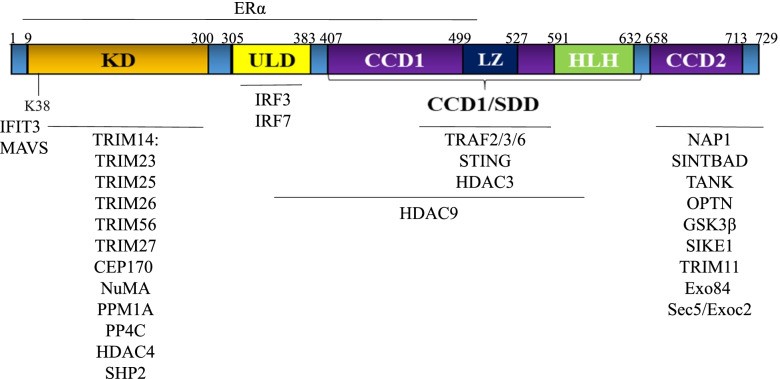
Fig1. TBK1 protein structure and interaction partners. (Austin P Runde, 2022)
What is TBK1 protein?
TBK1 (TANK binding kinase 1) gene is a protein coding gene which situated on the long arm of chromosome 12 at locus 12q14. TBK, also known as IkappaB kinase (IKK)-related kinase NAK, belong to the serine/threonine IKK kinase family and is thought to play a role in NF-kappa-B (NF-kappaB) activation. The NF-kappaB complex of proteins is inhibited by I-kappa-B (IKB) proteins,Which inactivate NF-kappaB by trapping it in the cytoplasm. The protein encoded by this gene is similar to IKB kinases and can mediate NF-kappaB activation in response to certain growth factors. For example, the protein can form a complex with the IKB protein TANK and TRAF2 and release the NF-kappaB inhibition caused by TANK. The TBK1 protein is consisted of 729 amino acids and its molecular mass is approximately 83.6 kDa.
What is the function of TBK1 protein?
TBK1, also known as NAK or NFkB-activating kinase, is an upstream protein kinase that can phosphorylate and activate the IkB kinases. Activation of IkB kinases allows the phosphorylation of IkB protein which is then degraded via the ubiquitination pathway. This mechanism allows the activation of the NFkB transcriptional complex. TBK1 is a specific upstream regulator of IkB kinases and can also interact and the IkB protein TANK. TBK1 is a component of the virus-activated kinase that phosphorylate IRF3 and IRF7 allowing their dimerization and translocation to the nucleus, where they induce transcription of interferon.
TBK1 Related Signaling Pathway
TBK1 protein is involved in the regulation of multiple signaling pathways. It mainly includes immune regulation, apoptosis and cell proliferation. In immune regulation, TBK1 is involved in the activation of Toll-like receptor (TLR) and RIG-I receptor (RLR) signaling pathways, or interacts with the transcription factor NF-κB to regulate inflammation and immune responses. In apoptosis, TBK1 is involved in regulating the signaling pathway of members of the fibroblast growth factor (FGF) family, regulating cell death and survival, and promoting the formation of autophagosomes through phosphorylation of Beclin-1. In addition, TBK1 is involved in cell cycle regulation and DNA damage repair during cell proliferation.
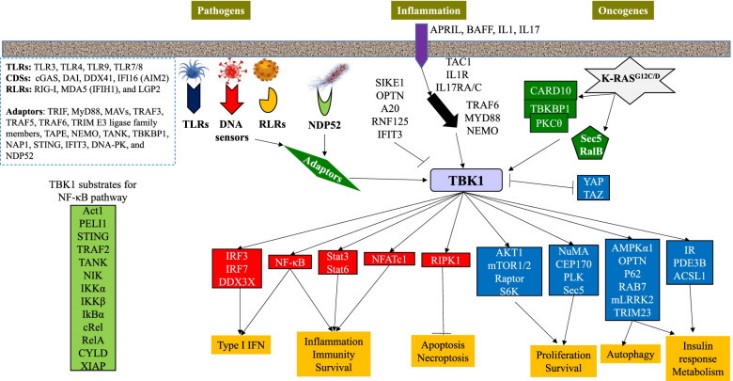
Fig2. TBK1-mediated signaling pathways. TBK1 activation is stimulated by pathogenic infections and inflammatory cytokines via corresponding receptors bridged by adaptor partners. (Austin P Runde, 2022)
TBK1 Related Diseases
Diseases associated with TBK1 protein mainly include immune-related diseases and tumors. In immune-related diseases, mutations or abnormal activation of TBK1 protein may lead to immune system disorders, triggering autoimmune diseases, such as systemic lupus erythematosus and rheumatoid arthritis. In addition, TBK1 protein also plays an important role in antiviral immunity, such as in infections such as influenza virus, Dengue virus and Ebola virus, TBK1 affects the host immune response by regulating the production of type I interferon. In the process of tumor development, the abnormal activation of TBK1 protein may promote the proliferation, invasion and metastasis of tumor cells, thus participating in the occurrence and progression of tumors, including breast cancer, liver cancer, lung cancer, etc. It has also been linked to neurodegenerative diseases.
Bioapplications of TBK1
Researchers are developing drugs that target TBK1 as a new strategy to treat inflammatory diseases, autoimmune diseases, and infections. fostamatinib, which is approved to treat conditions such as rheumatoid arthritis, psoriatic arthritis and ulcerative colitis, inhibits multiple tyrosine kinases, including TBK1. In addition, the TBK1 signaling pathway has also been used as a target for immune checkpoint therapy to improve immunotherapy responsiveness.
Case Study
Case study 1: Qiuli Jiang, 2023
Thyroid cancer has received increasing attention; however, its detailed pathogenesis and pathological processes remain unclear. The researchers investigated the role of TANK-binding kinase 1 (TBK1) in the progression of thyroid cancer. The function of TBK1 on thyroid cancer cells was detected using MTT, colony formation, wound healing, and Transwell assays. The xenograft assay was carried out to check on the role of TBK1 in thyroid cancer.
High expression of TBK1 raised viability, proliferation, migration, and invasion of thyroid cancer cells. Gene set enrichment analysis revealed that TBK1 activated the phosphatidylinositol-3-kinase/protein kinase B/mammalian target of rapamycin pathway. Cotransfection with Myc-associated zinc finger protein (MAZ) small-interfering RNA(siRNA) and TBK1 siRNA did not strengthen the inhibitory effect of TBK1 silencing on the thyroid cancer cells. The xenograft tumor assay showed that TBK1 short hairpinRNA inhibited tumor growth.
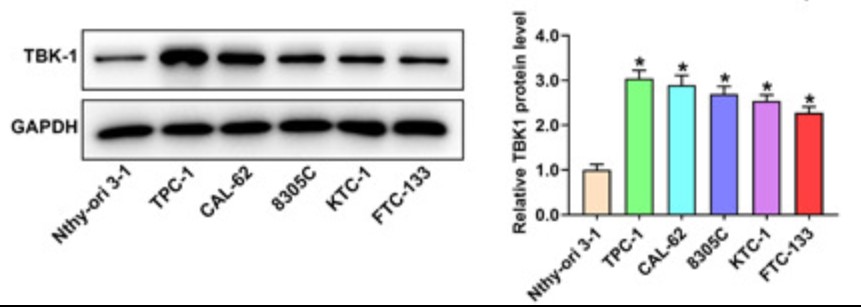
Fig1. TBK1 expression in cells. Band densities were determined using ImageJ Software and quantified as the ratio to GAPDH.
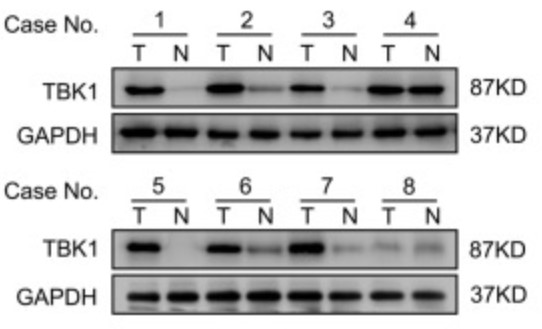
Case study 2: Chong-Qing Gao, 2023
Cholangiocarcinoma (CCA) is a highly heterogeneous and metastatic malignancy with a poor prognosis even after curative hepatectomy. Studies exploring its pathogenesis and identifying effective therapeutic targets are urgently needed.
In this study, TBK1 was upregulated in human tissues compared with nontumor tissues, and the elevated expression of TBK1 was positively correlated with larger tumour diameter, lymph node metastasis, and advanced TNM stage. Functional studies indicated that TBK1 promoted CCA growth and metastasis both in vitro and in vivo. TBK1 directly interacts with β-catenin, promoting its phosphorylation at the S552 site and its nuclear translocation. Besides, in the experimental group of 182 ICC patients, high TBK1 expression combined with high nuclear β-catenin expression predicted a worse prognosis. In summary, TBK1 might serve as a potential prognostic biomarker and therapeutic target for patients with CCA.

Fig3. Western blot analysis of TBK1 expression in CCA tumour and paired adjacent nontumor tissues. T, tumour tissue, N, peritumoral normal tissues.
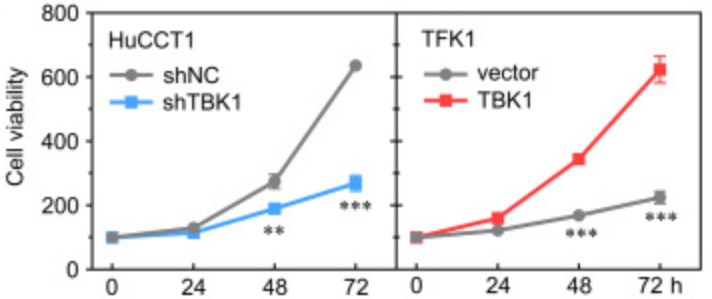
Quality Guarantee
High Purity
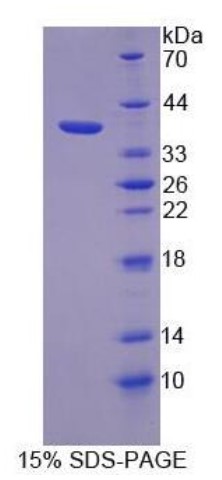
Fig1. SDS-PAGE (TBK1-657H) (PROTOCOL for western blot)
.
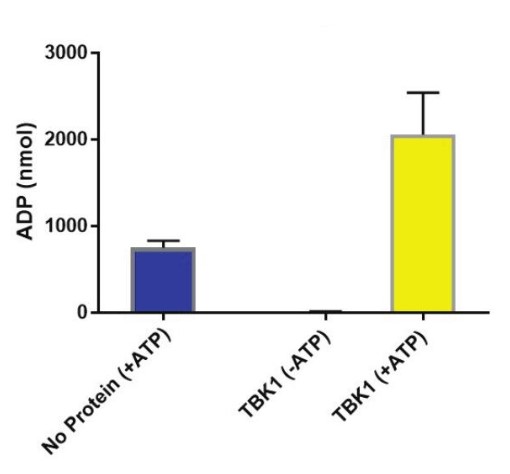
Fig2. Activity Data. (TBK1-010H)
Involved Pathway
TBK1 involved in several pathways and played different roles in them. We selected most pathways TBK1 participated on our site, such as Ras signaling pathway,Toll-like receptor signaling pathway,RIG-I-like receptor signaling pathway, which may be useful for your reference. Also, other proteins which involved in the same pathway with TBK1 were listed below. Creative BioMart supplied nearly all the proteins listed, you can search them on our site.
| Pathway Name | Pathway Related Protein |
|---|---|
| Cytosolic DNA-sensing pathway | TMEM173,IRF3,IKBKG,IFNA5,IFNA21,ADAR,POLR3GLB,POLR2K,RIPK3,IFNPHI3 |
| Epstein-Barr virus infection | POLR2B,SFPI1,HSPA6,MAP2K4,TP53,NFKBIA,TYK2,PSMD6,FGR,SND1 |
| Influenza A | RAE1,BMA1,IFNA16,MX1,NFKBIB,IFNA13,LOC100033925,TLR4,IRF9,DDX58 |
| Ras signaling pathway | KRAS,KITLG,CSF1,CALM1,LAT,SOS1,PAK2,IGF1,PLA2G12B,PLA2G2E |
| Measles | IFNA6,CD3G,PIK3CB,MAVS,TYK2,Cd209g,TAB2,HSPA1L,STAT5A,TP73 |
| Toll-like receptor signaling pathway | NFKB1,CXCL11,IL12BA,CD14,IRAK1,IFNA17,PIK3R5,IL12B,IFNA14,CD40 |
| Herpes simplex infection | IFNA16,UBE2R2,MHC2DCB,FB06F03,IL12B,PTPN11,HLA-DMB,SFRS9,HLA-G,MHC2A |
| Hepatitis B | GRB2,IKBKB,SMAD3,CCNE1,IFNA17,STAT5B,IKBKE,PRKCA,IFNA4,AKT1 |
| RIG-I-like receptor signaling pathway | SIKE1,RIPK1,MAP3K1,OTUD5A,IFNE,IFNA2,NFKBIB,TRAF6,IFNPHI1,IL12B |
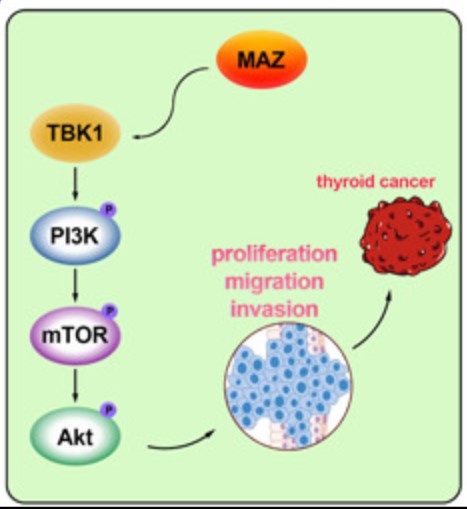
Fig1. A schematic model of TBK1 function in thyroid cancer. (Qiuli Jiang, 2023)
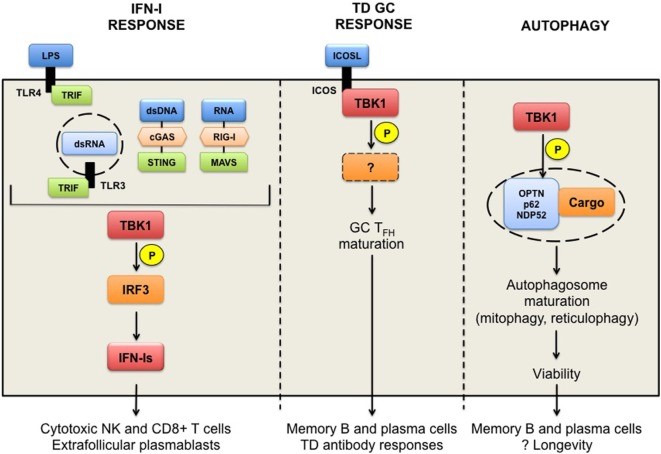
Fig2. TANK-binding kinase 1 (TBK1) in humoral responses. (Cynthia Louis, 2018)
Protein Function
TBK1 has several biochemical functions, for example, ATP binding,nucleic acid binding,phosphoprotein binding. Some of the functions are cooperated with other proteins, some of the functions could acted by TBK1 itself. We selected most functions TBK1 had, and list some proteins which have the same functions with TBK1. You can find most of the proteins on our site.
| Function | Related Protein |
|---|---|
| protein serine/threonine kinase activity | NEK10,PLK3,CDC42BPB,LIMK1,CSNK1D,STK35L,STK32B,SQSTM1,RIPK4,MAST2 |
| nucleic acid binding | R3HDM4,EIF4BA,HIVEP2A,ZIC2B,ZCCHC2,ZFP770,EXD2,KLF2A,SALL1A,U2SURP |
| ATP binding | GAK,KARS,PRKCA,CSNK1G2B,PAK7,DDX18,ABCD1,ATP2B1,KHK,ACTA1A |
| protein binding | CSK,GRIFIN,IL2RB,RIPPLY1,IL1RAPL1,CCNC,FBXO27,RERE,TH1L,F3 |
| protein kinase activity | ROCK1,NEK5,CSNK1D,FASTKD3,CDC42BPB,SNRKA,CHUK,SRPK1B,PAK2,CHEK1 |
| phosphoprotein binding | PLAT,TRPV1,PRKCSH,PIH1D1,MID2,DPYS,CBX4,SNCA,GPRIN1,THRAP3 |
Interacting Protein
TBK1 has direct interactions with proteins and molecules. Those interactions were detected by several methods such as yeast two hybrid, co-IP, pull-down and so on. We selected proteins and molecules interacted with TBK1 here. Most of them are supplied by our site. Hope this information will be useful for your research of TBK1.
TANK;IRF3;TBKBP1
Resources
Research Area
Related Services
Related Products
References
- Suzuki, T; Oshiumi, H; et al. Cell Type-Specific Subcellular Localization of Phospho-TBK1 in Response to Cytoplasmic Viral DNA. PLOS ONE 8:-(2013).
- Olagnier, D; Scholte, FEM; et al. Inhibition of Dengue and Chikungunya Virus Infections by RIG-I-Mediated Type I Interferon-Independent Stimulation of the Innate Antiviral Response. JOURNAL OF VIROLOGY 88:4180-4194(2014).




